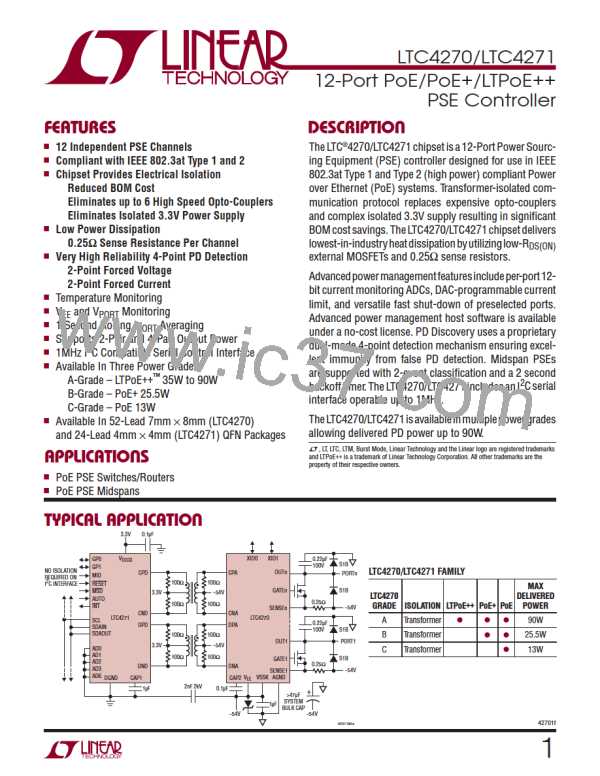LTC4270/LTC4271
APPLICATIONS INFORMATION
a power-on command unless the current detect result is
detect good. Any other detect result will generate a t
START
fault if a power-on command is received. In high power
mode the port must be placed in manual mode to force a
port on regardless of detect outcome.
275
FIRST
DETECTION
POINT
25kΩ SLOPE
165
BehaviorinAUTOpinmodeissimilartosemi-auto;however,
after detect good is reported and the port is classified (if
classification is enabled), it is automatically powered on
without further intervention. In standalone (AUTO pin)
SECOND
DETECTION
POINT
VALID PD
0V-2V
OFFSET
mode, the I
and I thresholds are automatically set;
VOLTAGE
CUT
LIM
42701 F12
see the Reset and the AUTO/MID Pins section for more
Figure 12. PD Detection
information.
The signature detection circuitry is disabled when the port
is initially powered up with the AUTO pin low, in shutdown
mode, or when the corresponding Detect Enable bit is
cleared.
Table 4. Detection Status
MEASURED PD SIGNATURE
Incomplete or Not Yet Tested
< 2.4k
DETECTION RESULT
Detect Status Unknown
Short Circuit
Detection of Legacy PDs
Capacitance > 2.7μF
C
too High
too Low
PD
2.4k < R < 17k
R
SIG
ProprietaryPDsthatpredatetheoriginalIEEE802.3afstan-
dardarecommonlyreferredtotodayaslegacydevices.One
type of legacy PD uses a large common mode capacitance
(>10ꢀF) as the detection signature. Note that PDs in this
range of capacitance are defined as invalid, so a PSE that
detects legacy PDs is technically noncompliant with the
IEEE spec. The LTC4270/LTC4271 can be configured to
detect this type of legacy PD. Legacy detection is disabled
bydefault,butcanbemanuallyenabledonaper-portbasis.
When enabled, the port will report Detect Good when it
sees either a valid IEEE PD or a high-capacitance legacy
PD. With legacy mode disabled, only valid IEEE PDs will
be recognized.
PD
17k < R < 29k
Detect Good
R too High
SIG
PD
> 29k
> 50k
Open Circuit
Voltage > 10V
Port Voltage Outside Detect Range
More on Operating Modes
The port’s operating mode determines when the LTC4270/
LTC4271 runs a detection cycle. In manual mode, the port
will idle until the host orders a detect cycle. It will then
run detection, report the results, and return to idle to wait
for another command.
In semi-auto mode, the LTC4270/LTC4271 autonomously
polls a port for PDs, but it will not apply power until com-
manded to do so by the host. The Port Status register is
updated at the end of each detection cycle.
CLASSIFICATION
802.3af Classification
A PD may optionally present a classification signature to
the PSE to indicate the maximum power it will draw while
operating. The IEEE specification defines this signature
as a constant current draw when the PSE port voltage is
Ifavalidsignatureresistanceisdetectedandclassification
is enabled, the port will classify the PD and report that
result as well. The port will then wait for at least 100ms (or
2secondsifmidspanmodeisenabled), andwillrepeatthe
detection cycle to ensure that the data in the Port Status
register is up-to-date.
in the V
range (between 15.5V and 20.5V), with the
CLASS
currentlevelindicatingoneof5possiblePDclasses.Figure
13 shows a typical PD load line, starting with the slope of
the 25k signature resistor below 10V, then transitioning to
If the port is in semi-auto mode and high power opera-
tion is enabled, the port will not turn on in response to
42701f
20

 Linear [ Linear ]
Linear [ Linear ]